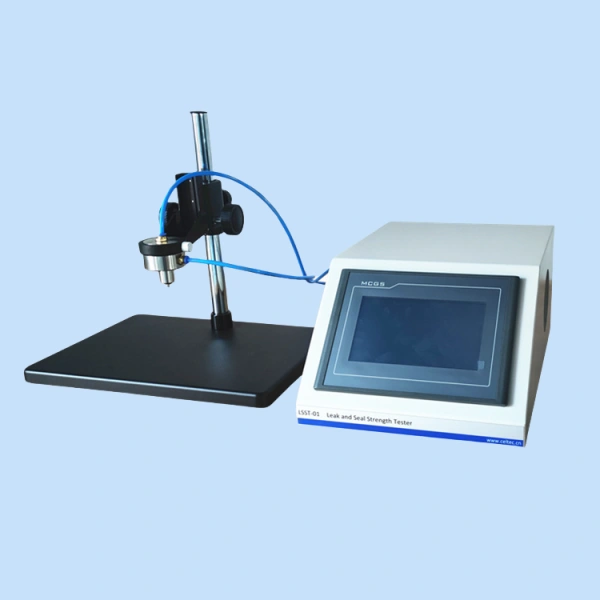pressure decay test
Ensuring packaging integrity is critical in the medical, pharmaceutical, and food industries. The ASTM F1140 standard offers comprehensive methods to assess the failure resistance of unrestrained packages under internal pressure. These include the burst test, creep testja pressure decay test, which simulate conditions encountered during sterilization, transport, and storage. This article explains the core of pressure decay test and how Cell Instruments provides advanced solutions to meet these testing requirements.
What Is ASTM F1140 and Pressure Decay Test?
ASTM F1140 is a standardized method developed by ASTM International for evaluating the internal pressurization failure resistance of flexible, unrestrained packages. It defines three main testing methods:
- Burst Test (Test Method A)
- Creep Test (Test Method B1)
- Creep to Failure Test (Test Method B2)
These methods help manufacturers identify weak seals, material inconsistencies, and design flaws that could compromise package integrity under pressure.
Understanding the Burst Test for ASTM F1140 Compliance
The burst test is one of the most common methods under ASTM F1140. It involves gradually increasing internal air pressure in a sealed package until it ruptures.
Purpose and Benefits:
- Identifies the maximum pressure a package can withstand.
- Evaluates the strength and consistency of seals.
- Simulates extreme conditions such as sterilization or altitude-related pressure changes.
Rakuinstrumendid Purske tester is designed specifically for ASTM F1140 burst testing. It allows users to precisely control the rate of pressurization and detect the exact pressure at which the package fails. This ensures repeatable, compliant, and accurate results.
Creep Test: Sustained Pressure Evaluation
The creep test (Test Method B1) evaluates how well a package maintains a set pressure over a fixed period, usually 15–30 seconds.
Applications:
- Process validation during packaging development.
- Detects slow leaks or weak points not visible in burst testing.
- Frequently used in medical device packaging, where sterility must be maintained under stress.
Cell Instruments’ test systems can maintain constant internal pressure with high accuracy. A recommended starting point is 80% of the known burst pressure, which ensures a meaningful challenge without immediate failure.
Creep to Failure: Pushing the Limits
A more aggressive form of the creep test, the creep to failure method (Test Method B2) increases pressure to around 90% of burst value and holds it until the package fails.
Why Use It?
- Assesses long-term pressure retention and seal degradation.
- Determines time to failure, which provides additional data for quality assurance.
This method is ideal for benchmarking performance under prolonged stress and detecting packaging defects that only emerge after sustained internal pressure.
Pressure Decay Test: A Non-Destructive Alternative
The pressure decay test, while not explicitly detailed in ASTM F1140, is often used in conjunction with the burst and creep tests. This method involves inflating the package to a set pressure and monitoring the decay rate over time.
Advantages:
- Non-destructive: Allows reuse of packages if no leakage is detected.
- Highly sensitive to micro-leaks.
- Useful in quality control environments that require rapid, reliable results.
Cell Instruments offers advanced systems that integrate pressure decay method testing, providing a full-suite solution for package integrity verification.
Key Parameters for Reliable Results
When performing ASTM F1140 tests, consistency is critical. Factors that affect test accuracy include:
- Package size and shape
- Seal configuration
- Material properties
- Pressurization rate
- Entry point location for closed packages
- Equipment sensitivity
All these must be controlled to ensure repeatable results across batches and test labs. Cell Instruments’ burst and pressure testers provide high-resolution control over each parameter.
Selecting the Right Instrument: COF-03 Coefficient of Friction Tester
Rakuinstrumendid provides a complete solution for ASTM F1140 testing, including burst, creep, and pressure decay capabilities. Our equipment offers:
- Precise pressure regulation and measurement
- User-friendly interfaces with programmable settings
- Automated data capture and reporting
- Compliant designs that align with ASTM standards
Our burst testers are widely used in medical device manufacturing, food packaging, and pharmaceutical QA processes.
Whether you’re validating new packaging materials, qualifying production lots, or investigating field failures, Cell Instruments’ systems ensure consistent and reliable test outcomes.
Contact Us Get Pressure Decay Test Testing Solution
ASTM F1140 plays a critical role in verifying the integrity of flexible packages subjected to internal pressure. By using appropriate methods like the burst test, creep testja pressure decay method, manufacturers can confidently assess seal strength, package design, and overall reliability.
For companies seeking precision and compliance, Cell Instruments’ burst testers are an ideal solution. Our equipment ensures your packaging meets regulatory expectations and performs flawlessly under pressure.
KKK-d
Industries like medical devices, pharmaceuticals, food packagingja electronics frequently rely on ASTM F1140 testing to ensure packaging integrity.
While not formally included in ASTM F1140, the pressure decay method is often used alongside it as a non-destructive alternative for leak detection.
A common guideline is to use 80% of the burst pressure for creep tests and 90% for creep-to-failure tests.
Not directly. ASTM F1140 evaluates failure resistance, while seal strength is usually assessed using ASTM F88.

